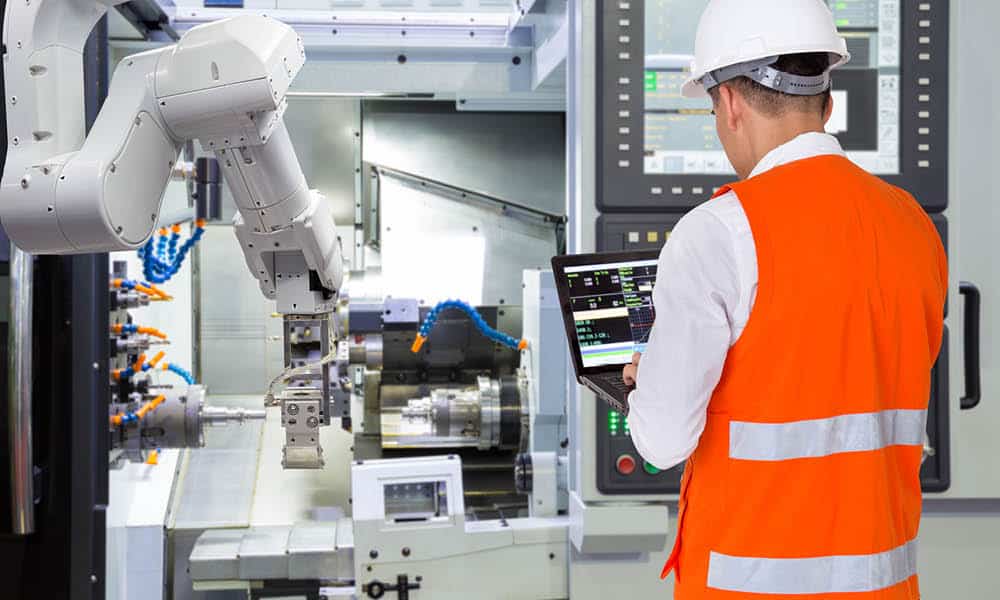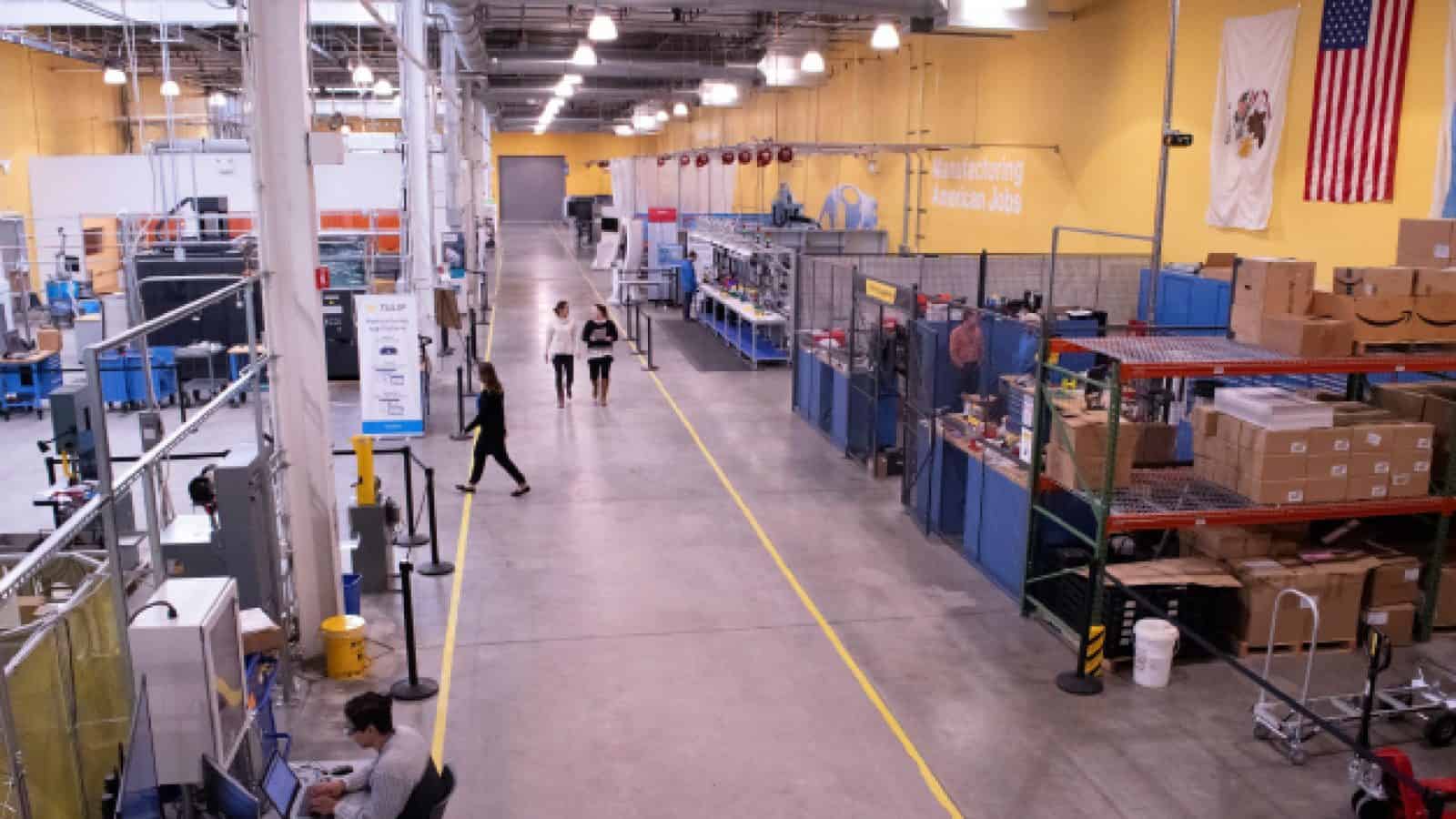Connectivity and AI Drive the Future of Manufacturing

Advanced networks and intelligent technologies are creating agile, secure and high-performing smart factories.

TAKEAWAYS:
● AI combined with fiber optics, 5G and edge computing is revolutionizing manufacturing.
● Real-world examples like digital twins, autonomous logistics and AI quality control show how this integration improves performance and flexibility.
● A strong framework of sensing, edge computing, hybrid networks, cloud analytics, workforce readiness and security is key to successful AI deployment in factories.
Advanced manufacturing is quickly changing from traditional assembly lines into smart, connected systems.
This shift is being fueled by the powerful combination of artificial intelligence and new connectivity technologies like fiber optics, 5G and edge computing. Together, these innovations help factories run more efficiently, flexibly and smoothly, ushering in a new age of smart manufacturing.
Connectivity: The foundation of AI-driven manufacturing
AI works best in manufacturing when it can quickly access and process massive amounts of data. That’s why strong connectivity is a key foundation for modern smart factories.
Fiber optics: The fast data highway
Fiber optic networks deliver extremely high bandwidth and low latency, which is essential to handle the large data streams from IoT sensors, machines and AI systems.
Unlike copper or wireless links, fiber offers stable, interference-free connections critical for time-sensitive manufacturing operations. This infrastructure supports centralized AI analytics, seamless inter-factory communications and cloud integration, helping smooth the flow of information and control commands.
Fiber connections also enhance security because they are less vulnerable to electromagnetic interference and eavesdropping, helping to protect sensitive manufacturing information from cyberattacks.
5G networks: Wireless freedom and scalability
While fiber serves fixed infrastructures, 5G offers wireless flexibility with multi-gigabit speeds and near-real-time responsiveness.
At industrial sites, 5G enables mobile robots, autonomous guided vehicles (AGVs) and wireless sensors to operate without the constraints of cables. In addition, 5G cellular signals travel farther and propagate better in challenging environments, which enables both workers and machines to get a more reliable connection to complete the workflow with more efficiency.
At non-industrial campuses, 5G enables dedicated airwaves that are not subject to the same interference challenges you get with unlicensed spectrum such as Wi-Fi, which means better overall performance.
The ability of 5G to create network slices means manufacturers can dedicate bandwidth and low-latency channels to mission-critical applications, helping to ensure that control signals have priority over less urgent data. This wireless freedom allows rapid reconfiguration of production lines and material flows without the expense and downtime of physical rewiring.
Moreover, 5G includes strong built-in security like encryption, authentication and network isolation, which helps protect important manufacturing processes from hacking and unauthorized access.
Edge computing: Smart processing close to the source
Edge computing tackles the delay and bandwidth challenges that come with sending all data to distant clouds.
By processing data locally on edge devices or gateways, AI models can make instantaneous decisions critical for real-time tasks such as quality inspection, machine control and safety monitoring. Edge computing also reduces network congestion and enhances data privacy, since sensitive information doesn’t always have to travel to the cloud. This hybrid approach balances the scalability of cloud computing with the responsiveness of edge processing.
Processing data at the edge minimizes exposure of sensitive operational data over networks, reducing the attack surface and enabling stronger data control and compliance with security policies.
Practical AI use cases in smart manufacturing
Digital twins for process optimization
One AT&T client, a major industrial equipment manufacturer, has successfully implemented AI combined with digital twin technology to optimize complex production processes.
Digital twins are precise virtual replicas of physical machines and factory operations, continuously fed real-time data from a dense network of sensors connected via fiber optics. AI algorithms compare digital twin simulations with actual performance, applying reinforcement learning to identify optimal process parameters. This dynamic adjustment improves yield, reduces energy use and minimizes waste.
Simultaneously, predictive maintenance models running on edge devices analyze vibration, temperature and acoustic data to forecast equipment failures. This shifts maintenance from reactive or scheduled downtime to prescriptive, condition-based interventions that minimize disruptions and extend equipment life. Centralized AI analytics platforms, supported by fiber optic connectivity, aggregate data across facilities for cross-site benchmarking and continuous improvement, fostering a data-driven, adaptive manufacturing environment.
Throughout these processes, robust cybersecurity measures such as encrypted data transmission, device authentication and continuous monitoring are critical to protecting the integrity of sensor data and AI models from tampering or cyber intrusions.
5G-enabled autonomous logistics
Another client, operating a large manufacturing plant, leverages AT&T wireless 5G connectivity to support a fleet of autonomous guided vehicles transporting components and finished goods.
The AGVs depend on reliable, low-latency communication to navigate dynamic factory layouts safely. A private 5G network employs a dedicated, local cellular network to help ensure mission-critical control signals have the coverage and capacity needed. Network slicing can take that coverage to another level by further prioritizing and partitioning resources to specific endpoints so in times of congestion, the mission critical endpoints get the resources needed. Onboard AI inference engines process sensor inputs in near real time, enabling immediate navigation and obstacle avoidance without delay.
This 5G-enabled wireless freedom allows the client to rapidly reconfigure production lines and material flows, avoiding costly rewiring or infrastructure changes. A centralized orchestration platform monitors the AGV fleet and dynamically assigns tasks to align with production schedules.
This setup highlights how combining AI with 5G connectivity removes physical constraints, enhances scalability and increases operational flexibility in manufacturing logistics.
The private 5G network environment also offers enhanced security by isolating critical communications from public networks, implementing strict access controls and enabling real-time threat detection to prevent unauthorized interference with autonomous vehicle operations.
AI-driven quality control at the edge—and in the cloud
A manufacturer specializing in high-precision components has revolutionized quality control by deploying AI-powered vision inspection systems integrated with edge and cloud computing.
High-speed industrial cameras capture tens of thousands of images per hour, transmitting them via fiber optics to edge servers where AI models perform real-time defect detection. These deep learning models help identify surface imperfections, dimensional deviations and assembly errors with accuracy surpassing human inspectors.
The AI systems continuously learn and adapt to new defect patterns emerging on the production line, helping to ensure consistent precision detection as product designs evolve. When defects are detected, immediate automated feedback loops remove faulty items and alert operators, reducing scrap and rework.
Meanwhile, aggregated data is sent to cloud platforms for long-term analytics and AI model retraining. This hybrid edge-cloud architecture balances the need for ultra-low latency responses with scalable training and analytics, underscoring the critical role connectivity plays in intelligent, responsive quality assurance.
Securing both edge and cloud environments with encryption, multi-factor authentication and compliance with data privacy standards helps ensure that sensitive product quality data remains protected while enabling effective AI-driven insights.
A framework for AI and connectivity integration
An effective framework for deploying AI and connectivity in manufacturing could include:
- Sensing and data acquisition: A dense array of diverse IoT sensors—measuring vibration, heat, light and sound—form the data foundation. These connect through a mix of fiber optics for fixed, high-speed links and 5G for wireless flexibility. Proper sensor calibration helps ensure data quality.
- Edge computing layer: Rugged edge devices run AI models locally for tasks needing fast response. Containerized AI allows easy updates and scaling for real-time detection, control and inspection without relying only on the cloud.
- Connectivity infrastructure: A hybrid network blends fiber optics’ high bandwidth and low latency with 5G’s mobility and scalability. Network slicing and Quality of Service (QoS) prioritize critical traffic to keep safety and control systems running smoothly. Security protocols like encryption and continuous monitoring protect data from cyber threats.
- Cloud and centralized analytics: Cloud platforms gather data from multiple edges for advanced AI training, trend analysis and factory benchmarking. They offer easy-to-use dashboards and decision tools to help operators and managers.
- Integration and orchestration: AI systems connect seamlessly with Manufacturing Execution Systems (MES), Enterprise Resource Planning (ERP) and supply chain software for closed-loop automation. AI insights automatically adjust processes or alert staff, while humans oversee and improve operations.
- Ethical and workforce considerations: Transparent AI models build trust, especially for safety-critical uses. Training programs boost employee skills in AI and data to prepare them for working alongside AI. Strong data governance helps ensure compliance and privacy.
Strategic benefits and the future of smart manufacturing
The convergence of AI and connectivity goes beyond incremental improvements to fundamentally reshape manufacturing capabilities:
- Operational efficiency: Predictive maintenance and process optimization reduce downtime and resource use.
- Quality excellence: Real-time adaptive vision inspection improves product consistency and reduces waste.
- Logistical agility: Wireless 5G helps enable flexible material handling and rapid factory reconfiguration.
- Supply chain resilience: Integrated AI analytics provide end-to-end visibility and proactive disruption management.
- Workforce empowerment: Collaborative AI tools augment human expertise, fostering innovation and upskilling.
For leaders, adopting AI and connectivity as linked strategies is key.
Building these technologies into unified digital systems tailored to each factory’s needs will be vital for staying competitive. As these technologies evolve, future smart factories will use even smarter AI, quantum computing and next-gen connectivity to create truly autonomous, self-optimizing manufacturing.
Making sure these future systems have security built in from the start is crucial to protect valuable knowledge, keep operations running and build trust in fully autonomous factories. M
About the Author:

Ande Hazard is Vice President of Manufacturing, Transportation and Financial Services solutions, AT&T Business
